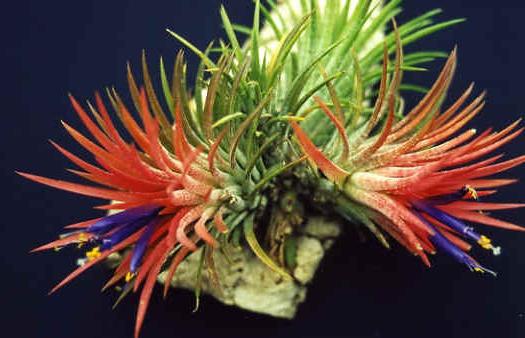Tillandsia is one of the interesting ornamental plants. In the wild, it has a wide distribution range - from the southern territories of the USA to Chile. Now more than four hundred species of this plant are known. Tillandsia has amazing adaptability and excellent growth in a wide variety of climatic conditions - in the arid savannah, in tropical forests, in the semi-desert and even on the border with permafrost.
Due to the wide distribution in different climatic zones, plants of the genus Tillandsia can seriously vary in appearance. As a rule, their root system is poorly developed, it is designed to fix the plant on various surfaces. Tillandsia leaves have taken on the function of nutrition and the accumulation of valuable substances: they vary greatly in shape and color, can be narrow, elongated, flat and long, gray or green, rough and smooth. Plants of the genus Tillandsia can have a powerful stem, and can be completely without it.
Some species bloom very beautifully and for a long time, with bright and
graceful flowers. In this article we will talk about how tillandsia is grown. Home care for this plant consists of several basic agricultural procedures that need to be done regularly. Due to its attractive appearance, this plant is able to refresh and decorate the interior of any room.
The original plant for your home - tillandsia
Care at home for this flower implies the correct choice of its location. Tillandsia loves bright lighting, but prefers soft diffused light, rather than direct sunlight. For a plant, it is desirable to allocate a place on the western or southern window.

If the rays of the sun fall on it on the windowsill, you should shade the flower with the help of blinds or tulle. In addition to window sills, the plant can be placed on supports, shelves, racks not far from windows. In the climatic conditions of central Russia, in the winter, the plant must be additionally illuminated with a fluorescent lamp, otherwise its leaves may become dull. Tillandsia loves warmth at home, therefore it is necessary to maintain the temperature for it in the range from 22 ° C to 29 ° C in summer (at night about 16 ° C), and not lower than 18 ° C in winter (at night also 16 ° C). Tillandsia does not tolerate drafts, a strong decrease or increase in temperature. For hardening, it’s good to take the pot with the plant to the balcony or to the garden in the summer (remember that on the street the flower must be protected from rain).
Tillandsia: home care (watering, fertilizer, transplant)
Watering the plant should be regular and sufficient. The soil in the pot should never dry out, but at the same time, the plant should not be overfilled. Remember that when water stagnates, the roots of tillandsia can begin to rot and die. In winter, watering is slightly reduced so that the earthen lump has time to dry out. For this, soft, settled water is used. In general, tillandsia loves high humidity, so you should periodically spray it with not very cold water.
Important: during flowering, it is not recommended to spray the plant. Some species of tillandsia are watered by immersing the pot in a pan with water. Tillandsia, which is not very difficult to care for at home, also loves the necessary nutrition. We advise you to purchase a special fertilizer for orchids and apply it twice a month. In winter, tillandsia is not fed.
A plant transplant is carried out if necessary, when there is a slowdown in flower growth, the cessation of its flowering, and the old pot becomes cramped. As a rule, transplantation is carried out once every several years. In order to transplant tillandsia, they select a wide, but not very deep capacity, and fill it with a substrate of sphagnum moss, pine bark, peat, leafy humus and fern roots. With proper and timely care in the conditions of a city apartment, amazing tillandsia will grow perfectly. Flowering of this plant will decorate and revitalize any room for a long time, making it more comfortable.